Overview
Navigating the journey to become a government contractor can feel overwhelming at times. You may find yourself assessing your organizational capabilities, conducting market research, and trying to understand the myriad registration and certification requirements. It’s completely normal to feel uncertain in this competitive landscape. But remember, you are not alone in this process.
We understand that leveraging resources, such as the Small Business Administration, can make a significant difference. Engaging in networking opportunities not only opens doors but also builds a community of support around you. Imagine the possibilities that can unfold when you connect with others who share your aspirations.
Ultimately, these steps can lead to substantial growth and stability for small businesses like yours. By taking action and seeking guidance, you can enhance your chances of success in this field. Embrace the journey, and know that with the right support and resources, you can achieve your goals.
Introduction
In the intricate world of government contracting, we understand that businesses face both unique challenges and remarkable opportunities. As the landscape evolves, particularly in 2025, grasping the nuances of securing government contracts becomes paramount for companies striving to thrive. With significant federal spending and a growing emphasis on transparency, small and minority-owned businesses are carving out their space in this competitive arena.
Navigating the registration process can feel overwhelming, and crafting compelling proposals may seem daunting. You are not alone in this journey. Aspiring contractors must equip themselves with the right knowledge and strategies to succeed. This article delves into the essential elements of government contracting, offering insights and guidance designed to empower you to seize the opportunities that lie ahead. Together, we can explore these vital steps toward your success.
Understanding Government Contracting: An Overview
Public sector procurement is a vital pathway for companies aspiring to become government contractors. It offers a diverse range of products and services while fostering interactions with public entities. As we look toward 2025, the landscape of government procurement reveals a significant challenge: an estimated $131.8 billion of federal spending in 2021 remains unaccounted for. This statistic highlights the critical need for transparency and accountability in procurement processes, a concern echoed by industry experts.
Current trends indicate a notable increase in contract awards for small businesses, a crucial aspect for those looking to navigate the world of government contracting. Despite a decline in prime opportunities, this shift underscores the importance of small and minority-owned businesses in the federal procurement landscape. The Small Business Administration (SBA) has begun releasing disaggregated data on federal contracting with these firms, promoting transparency and support. We understand that this trend can feel overwhelming, but it also signifies a growing recognition of the vital role these enterprises play.
There are many successful examples in sectors like disaster relief and emergency preparedness, where federal authorities prioritize contracts in logistics, construction, healthcare, and emergency management. Contractors are encouraged to enhance their visibility by updating their System for Award Management (SAM) profiles with keywords like ‘Disaster Relief’ and emphasizing their rapid response capabilities. This proactive approach not only positions businesses favorably but also aligns with the rising emphasis on preparedness. You are not alone in this journey; following these strategies can provide valuable insights on how to become a government contractor and lead to substantial growth opportunities in these critical sectors.
Expert insights further illuminate the complexities of public procurement processes. Industry leaders, including Mona Sehgal, Director at GAO, emphasize that ‘GAO’s fact-based, nonpartisan information assists Congress and federal agencies in enhancing public administration.’ This underscores the importance of grasping the subtleties of official agreements to maneuver the competitive environment effectively. We recognize that this can be daunting, but understanding these nuances can empower you as you navigate your path.
In summary, understanding how to become a government contractor in 2025 presents both challenges and opportunities. By grasping the fundamental aspects of agreements and staying updated on the latest trends, you can strategically position yourself for success in this dynamic environment. Remember, you are not alone, and with the right knowledge and support, these challenges can transform into opportunities for growth.
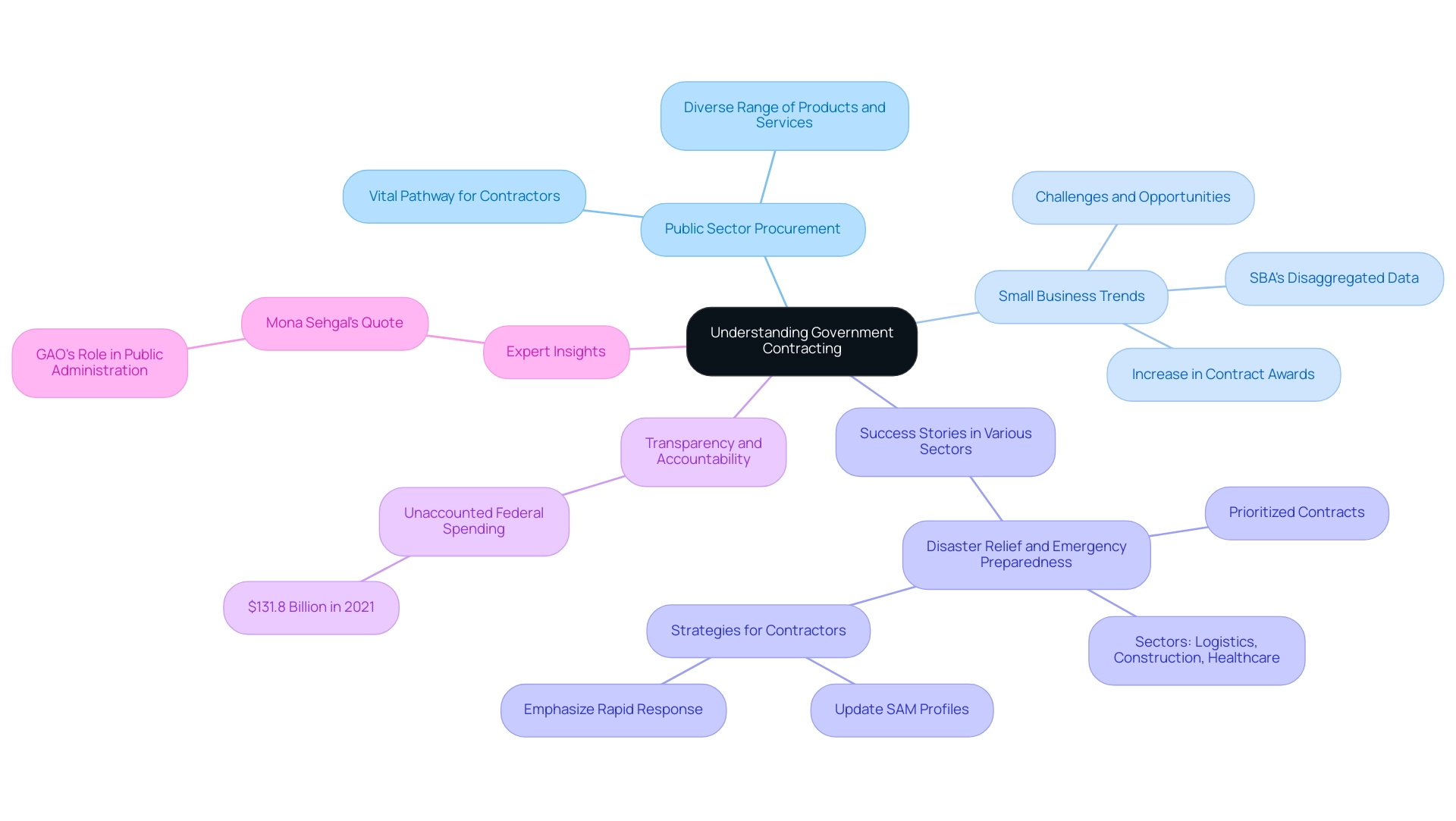
The Significance of Government Contracts for Businesses
Public sector agreements present an incredible opportunity for those looking to navigate the path of becoming a government contractor. The U.S. government stands as one of the largest purchasers of products and services, and securing a public sector agreement can provide small enterprises with a steady income, foster lasting partnerships, and enhance their reputation in the marketplace. Importantly, these agreements often face less competition compared to the private sector, making them particularly appealing for small businesses eager to expand their reach.
As we look ahead to 2025, small enterprises are anticipated to capture a significant share of public sector agreements, with projections indicating they accounted for approximately 23% of federal spending on contracts. This trend underscores the vital role that public sector agreements play in nurturing the growth and stability of small businesses, especially for those transitioning careers who aspire to learn how to become a government contractor amidst an ever-changing economy. Moreover, companies that skillfully navigate the public procurement landscape can experience a substantial increase in revenue; research shows that businesses awarded public contracts report an average revenue growth of 30% within their first year.
The diversity of small business ownership is also crucial in this arena. For example, Hispanic-owned businesses make up 5.6% of U.S. employer firms, while African-American and Asian-owned businesses represent 2.2% and 9.7%, respectively. This diversity highlights the need for inclusive support systems that empower various communities in entrepreneurship, particularly in public sector procurement.
The Entrepreneur’s Source plays a significant role in this context, offering Career Ownership Coaching™ that helps individuals grasp the nuances of becoming a government contractor, ultimately enhancing their career prospects and promoting financial independence.
Additionally, Parnell Woodard, a dedicated Career Ownership Coach, emphasizes the importance of guiding clients toward achieving their career goals, particularly when discussing how to become a government contractor. His coaching services are tailored to help clients identify and harness their transferable skills, ensuring they can thrive in the evolving job market. In today’s landscape, it’s noteworthy that 41% of local enterprises depend on social media to generate revenue, with 96% integrating it into their marketing strategies.
This digital engagement can be pivotal for small businesses aiming to connect with public agencies and showcase their capabilities, especially given that 91% of clients prefer to partner with small firms when possible.
Ultimately, understanding how to become a government contractor offers benefits that extend beyond immediate financial gains; it can significantly impact a small entity’s long-term sustainability and growth trajectory. As the contracting market continues to evolve, small enterprises that seize these opportunities, supported by effective coaching and community involvement, will be well-positioned to flourish.
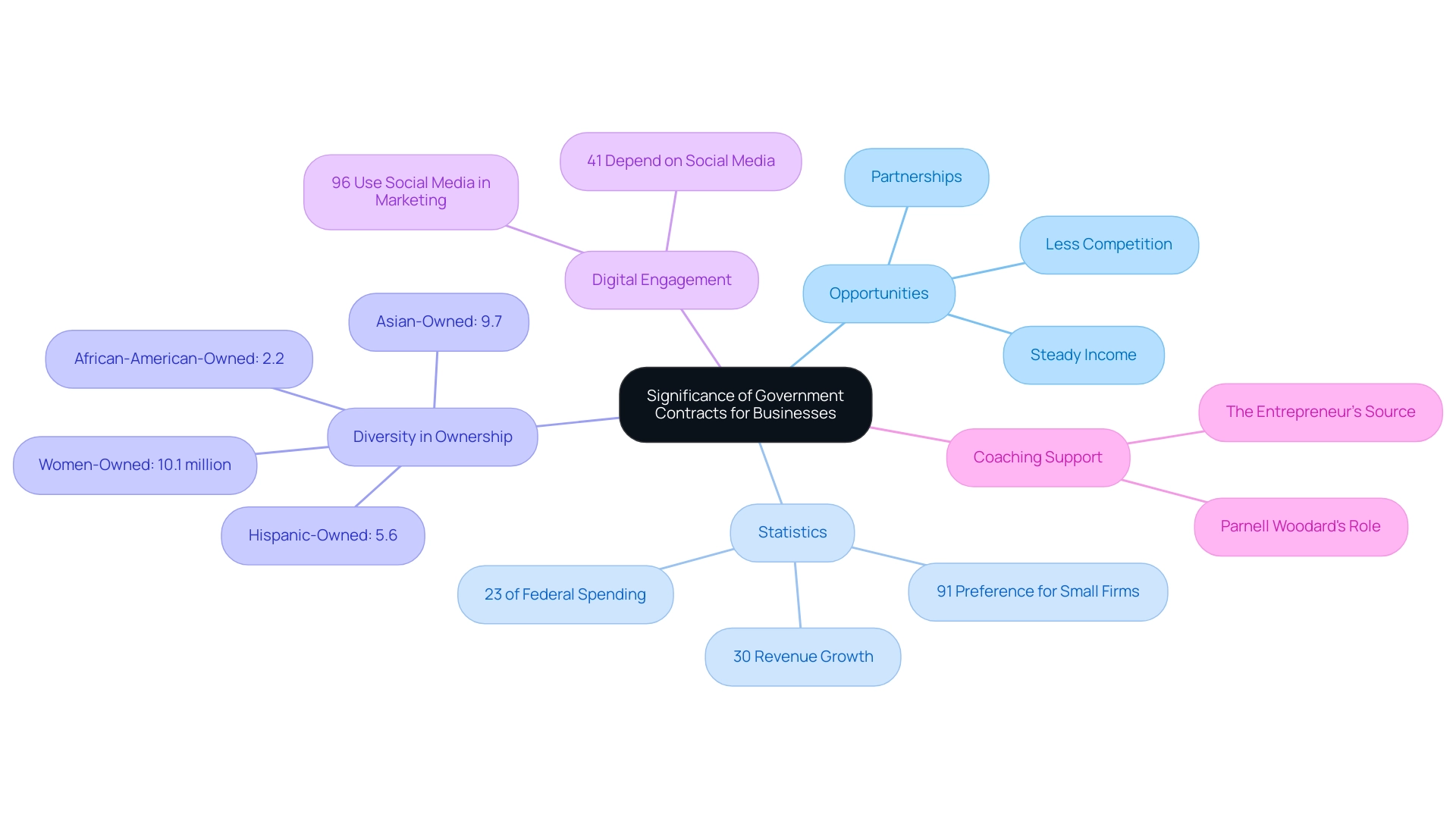
Initial Steps to Becoming a Government Contractor
Embarking on the journey to become a government contractor can feel daunting, but with a strategic approach, you can navigate this path successfully. The first step is to assess your organizational capabilities thoroughly, ensuring you meet the necessary qualifications. Take a moment to identify the specific services or products your company can offer and consider which government agencies might need them. Remember, recognizing your distinct strengths will help position your enterprise effectively in the procurement landscape.
Next, conducting comprehensive market research is crucial. This research should focus on identifying potential procurement opportunities, analyzing competitors, and understanding the current market dynamics. Did you know that in 2025, contracting opportunities are expected to increase significantly? Staying aware of trends and demands within the sector is vital for your success.
Once you have a clear understanding of your capabilities and the market landscape, it’s time to prepare your venture for becoming a government contractor. This preparation involves gathering essential documentation such as tax identification numbers, operating licenses, and any certifications necessary for contracts with authorities. It’s important to be aware that delinquent federal taxes exceeding $10,000 can lead to contractor suspension. Maintaining compliance and good standing is crucial for your journey.
At Find Your Career 2.0, we offer coaching services designed to help you understand and manage these compliance requirements effectively. You are not alone in this process; we are here to support you.
Additionally, exploring funding options available through the U.S. Small Business Administration can provide essential financial assistance for small businesses aiming to enter the contracting sector. These funding opportunities, including loans and grants, can empower you to invest in necessary resources and navigate credit repair. Imagine fostering career resilience and achieving financial freedom! Find Your Career 2.0 also provides no-cost coaching services to help you identify and apply for these funding options, ensuring you have the financial backing needed to succeed.
Seeking insights from successful contractors can also offer valuable guidance. Many have shared how thorough preparation and understanding the specific requirements of public contracts were key to their success. As Parnell Woodard, a Career Ownership Coach at Find Your Career 2.0, wisely states, “Transitioning to public sector work requires not just understanding the market but also having the right support and resources to navigate the complexities involved.”
By adhering to these preliminary actions and utilizing professional guidance, including the free coaching services and organized approach provided by Find Your Career 2.0, you can gain a clearer understanding of how to become a government contractor. Together, we can prepare you for success in the competitive realm of public procurement.
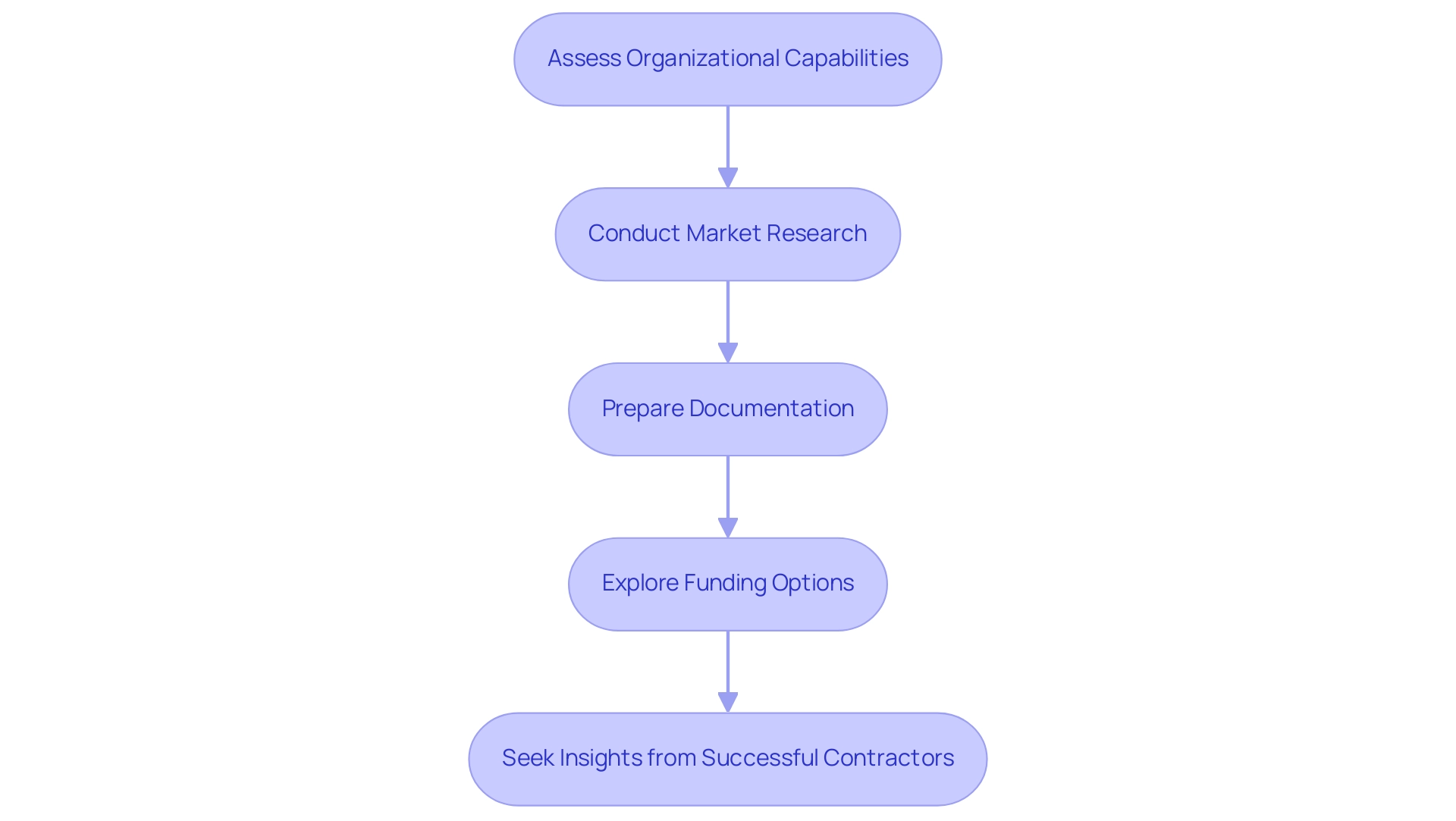
Navigating Registration and Certification Requirements
Navigating the registration process in the System for Award Management (SAM) can feel overwhelming, but it’s a vital step for entities aspiring to become government contractors. Understanding how to legally function as a contractor for the state begins with obtaining a Unique Entity Identifier (UEI). This identifier is crucial for all entities wishing to engage in government contracting. As we approach 2025, it’s important for companies to confirm their status as small enterprises if applicable, as this designation significantly impacts eligibility for various agreements.
In addition to the UEI, pursuing specific certifications—like those for minority-owned or veteran-owned enterprises—can be beneficial. These certifications not only enhance an organization’s credibility but also open doors to set-aside agreements designed for qualified entities. For instance, a recent case study illustrated how a veteran-owned enterprise successfully secured a public contract after obtaining the necessary certifications, showcasing the tangible benefits of this process.
The current registration statistics for SAM reveal a growing number of enterprises recognizing the importance of these registrations. As of 2025, the number of registered entities has surged, reflecting a heightened interest in contracting opportunities. Industry specialists emphasize that learning how to become a government contractor involves more than just a formality; finalizing these registrations and certifications is essential for any enterprise aiming to bid on public contracts effectively.
Moreover, recent updates regarding the Unique Entity Identifier requirements highlight the need for organizations to stay informed about their registration status. Existing entities can verify their UEI in their Entity Workspace, ensuring they are prepared to engage in public sector business without delays. Additionally, small enterprises should explore funding options provided by the U.S. Small Enterprise Administration (SBA), which can offer crucial financial support for navigating the public procurement landscape.
Programs like the SBA 7(a) loan and the SBA Microloan program can be especially advantageous for companies looking to secure contracts.
As Parnell Woodard, a Career Ownership Coach, insightfully notes, “Empowering clients to navigate these complexities is vital for reaching their career objectives in public procurement.” This structured approach to registration and certification, combined with the extensive experience and no-cost coaching services offered by The Entrepreneur’s Source, is essential for businesses aspiring to understand how to become a government contractor in today’s competitive environment.

Exploring Different Types of Government Contracts
Government agreements can often feel overwhelming, but understanding them is key to navigating your path in the public sector. These agreements are classified into various categories, each with unique regulations and consequences for pricing and performance. Among the most common are fixed-price agreements and cost-reimbursement agreements. Fixed-price agreements offer a predetermined payment for services rendered, providing clarity and predictability for both contractors and the government. This stability can be reassuring as you embark on your journey.
On the other hand, cost-reimbursement agreements cover allowable expenses incurred during a project. This can be particularly advantageous for initiatives with uncertain scopes or evolving requirements, as it allows for flexibility in managing costs.
As we look ahead to 2025, it’s important to note that the average payment terms for fixed-price arrangements typically range from 30 to 60 days post-invoice. In contrast, cost-reimbursement agreements may involve longer payment cycles due to the necessity for detailed cost documentation and approval processes. Understanding these payment dynamics is crucial for companies striving to manage cash flow efficiently, and we recognize that this can be a source of stress.
In addition to fixed-price and cost-reimbursement agreements, there are indefinite delivery arrangements. These allow for the provision of supplies or services over a defined timeframe without a set quantity, offering flexibility that can be beneficial for contractors facing changing demands.
Statistics from 2025 reveal that fixed-price agreements represent around 60% of public sector award distributions, highlighting their appeal among agencies seeking budget stability. While cost-reimbursement agreements may not be as prevalent, they are often used for research and development initiatives where expenses can be uncertain. This knowledge can empower you as you consider your options.
Moreover, contractors must be aware of the Cybersecurity Maturity Model Certification, which needs to be obtained by December 2024. This regulatory change is essential for adherence in the public procurement sector. We understand that keeping up with new dynamics, including federal staff reductions and regulatory changes, can feel daunting, but grasping these elements is essential for navigating the landscape of agreements.
Expert insights suggest that the choice between fixed-price and cost-reimbursement arrangements often hinges on the project’s nature and the contractor’s risk tolerance. Specialized professionals stress that understanding the subtleties of each agreement type can greatly influence a contractor’s success in the federal marketplace. You are not alone in this journey; many have navigated these waters successfully.
Parnell Woodard, a Career Ownership Coach, emphasizes the importance of moving toward career ownership. He highlights how becoming a government contractor can be a viable option for individuals seeking new opportunities. Case studies illustrate the significance of adapting to the changing environment of public sector procurement. For instance, organizations managing fixed-rate agreements have successfully leveraged market intelligence and competitive analysis to refine their bidding strategies, ensuring they remain competitive amid evolving policies and workforce dynamics.
By utilizing Price-To-Win (PTW) strategies, contractors can proactively evaluate market trends, enhancing their chances of securing profitable public sector agreements.
In summary, a comprehensive understanding of the various categories of public sector agreements, including their payment terms and implications, is essential for enterprises aiming to navigate the intricacies of public sector procurement successfully. The Entrepreneur’s Source offers a personalized approach to career coaching, providing support for individuals on how to become a government contractor. Remember, you have the power to shape your future.
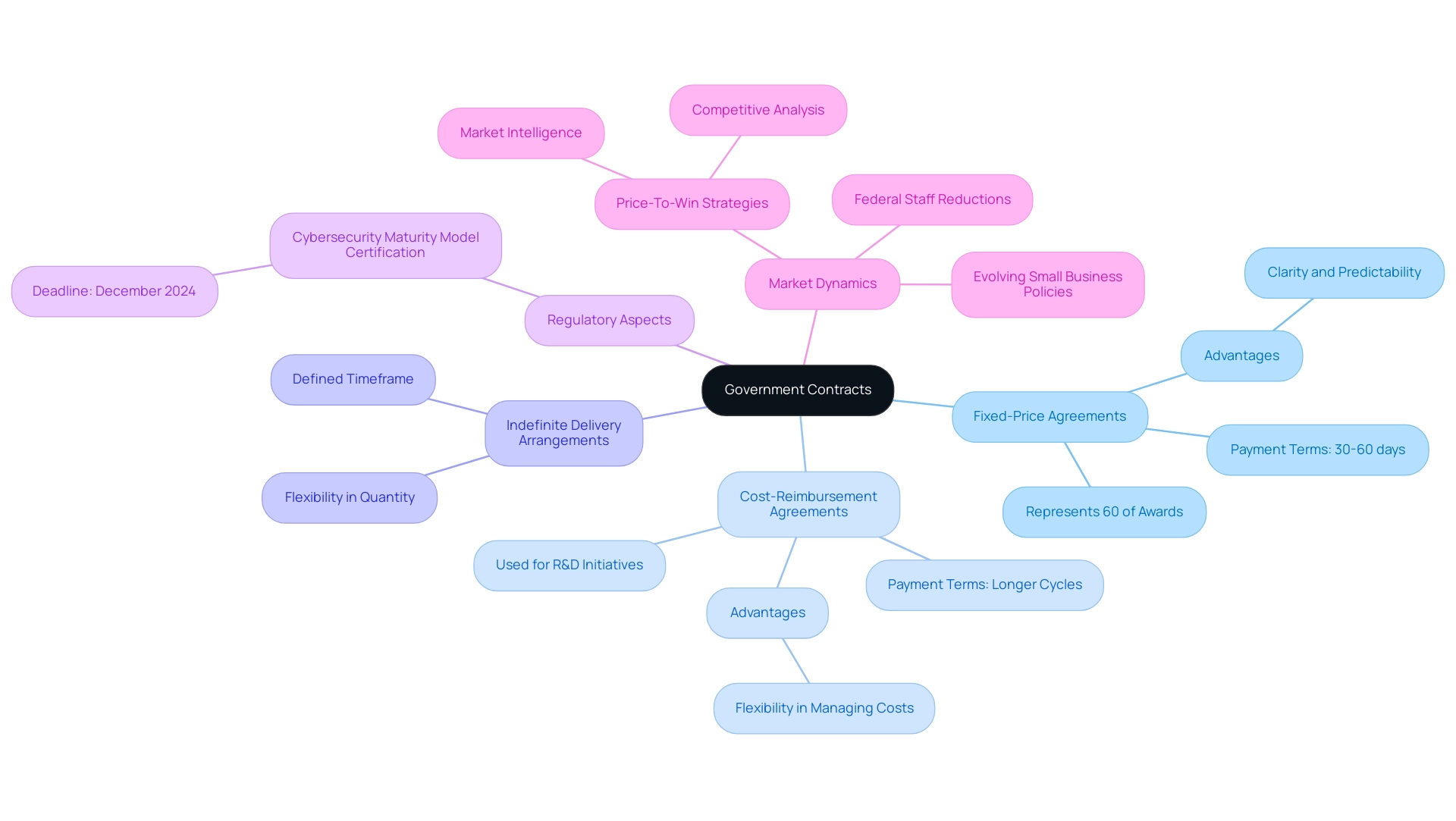
Crafting Winning Proposals and Bidding Strategies
Understanding how to become a government contractor can feel daunting, but you are not alone in this journey. Businesses must create persuasive proposals that effectively showcase their capabilities, experience, and unique value proposition. This process begins with a thorough response to Requests for Proposals (RFPs), where detailed plans must meet the specific needs of the public agency. A strategic approach to bidding is essential; companies should focus on contracts that align with their core strengths and ensure strict compliance with all submission requirements.
In 2025, the landscape for becoming a government contractor is particularly promising, with significant opportunities emerging from infrastructure projects and advancements in artificial intelligence. Small and midsize enterprises (SMEs) have maintained a steady RFP win rate of 42% over the past three years. However, the gap between SMEs and larger enterprises is widening, as larger organizations leverage stronger brand recognition and resources. It is increasingly important for SMEs to grasp how to become a government contractor to remain competitive.
To enhance the credibility of their proposals, businesses should utilize past performance data and client testimonials. These elements can significantly bolster their case, offering reassurance to potential clients.
Expert guidance suggests that contractors seeking to learn how to become a government contractor should begin by performing a critical assessment of their opportunity pipeline, ensuring they focus on the most suitable projects. As Clint Woofter, Director of Artificial Intelligence & Machine Learning Compliance, advises, “Contractors can start by undertaking a critical review of their opportunity pipeline.” Successful contractors understand the importance of tailoring proposals to meet the specific requirements of each RFP, which can dramatically increase the chances of winning contracts.
By embracing these strategic bidding techniques and concentrating on how to become a government contractor through successful proposals, organizations can navigate the complexities of public sector procurement and position themselves for success in this competitive field. For those transitioning careers, leveraging the personalized coaching and no-cost services offered by The Entrepreneur’s Source can provide invaluable support in navigating this landscape and achieving professional goals. Remember, you are not alone in this process, and there are resources available to help you thrive.
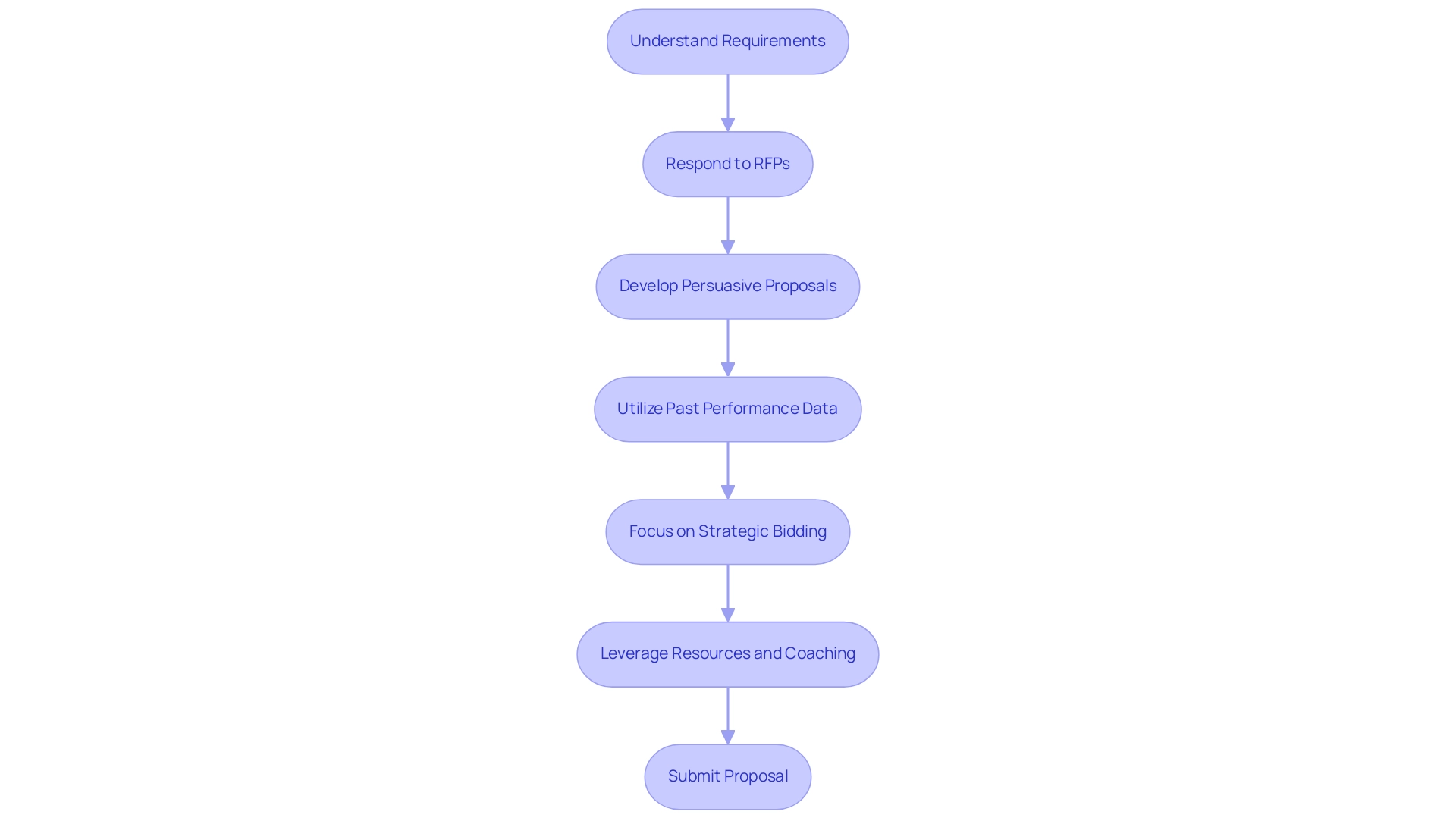
Building Relationships: Networking in Government Contracting
Building strong connections within the contracting community is essential for understanding how to become a government contractor and attain success. We understand that navigating this path can feel overwhelming, but participating in industry events and networking sessions offers a valuable opportunity to connect directly with key stakeholders and officials. In 2025, the emphasis on networking has intensified, especially as small businesses in priority sectors such as defense, public health, cybersecurity, and clean energy are well-positioned to seize emerging opportunities.
Did you know that agencies often spend up to 30% of their budgets during the fourth quarter? This creates a critical window for contractors to secure contracts. Joining professional organizations can significantly enhance your networking efforts, providing access to valuable resources and connections. Additionally, leveraging social media platforms can facilitate ongoing engagement and visibility within the public sector. Statistics indicate that effective networking can lead to a 70% increase in agreement opportunities, underscoring the importance of building a robust professional network.
Furthermore, fostering relationships with government officials is essential. These connections can offer you insights into forthcoming agreements and procurement procedures, giving your firm a competitive advantage. Successful case studies, such as ‘Maximizing the Q4 Sprint,’ highlight that companies prioritizing relationship-building often secure contracts more efficiently, particularly during critical periods like the fourth quarter when agencies rush to obligate remaining funds.
By adopting strategic networking practices, you can enhance your presence and success while learning how to become a government contractor. As Parnell Woodard, a Career Ownership Coach, emphasizes, empowering clients to transition into new opportunities is key to achieving their career goals. Remember, you are not alone in this journey; we are here to support you every step of the way.
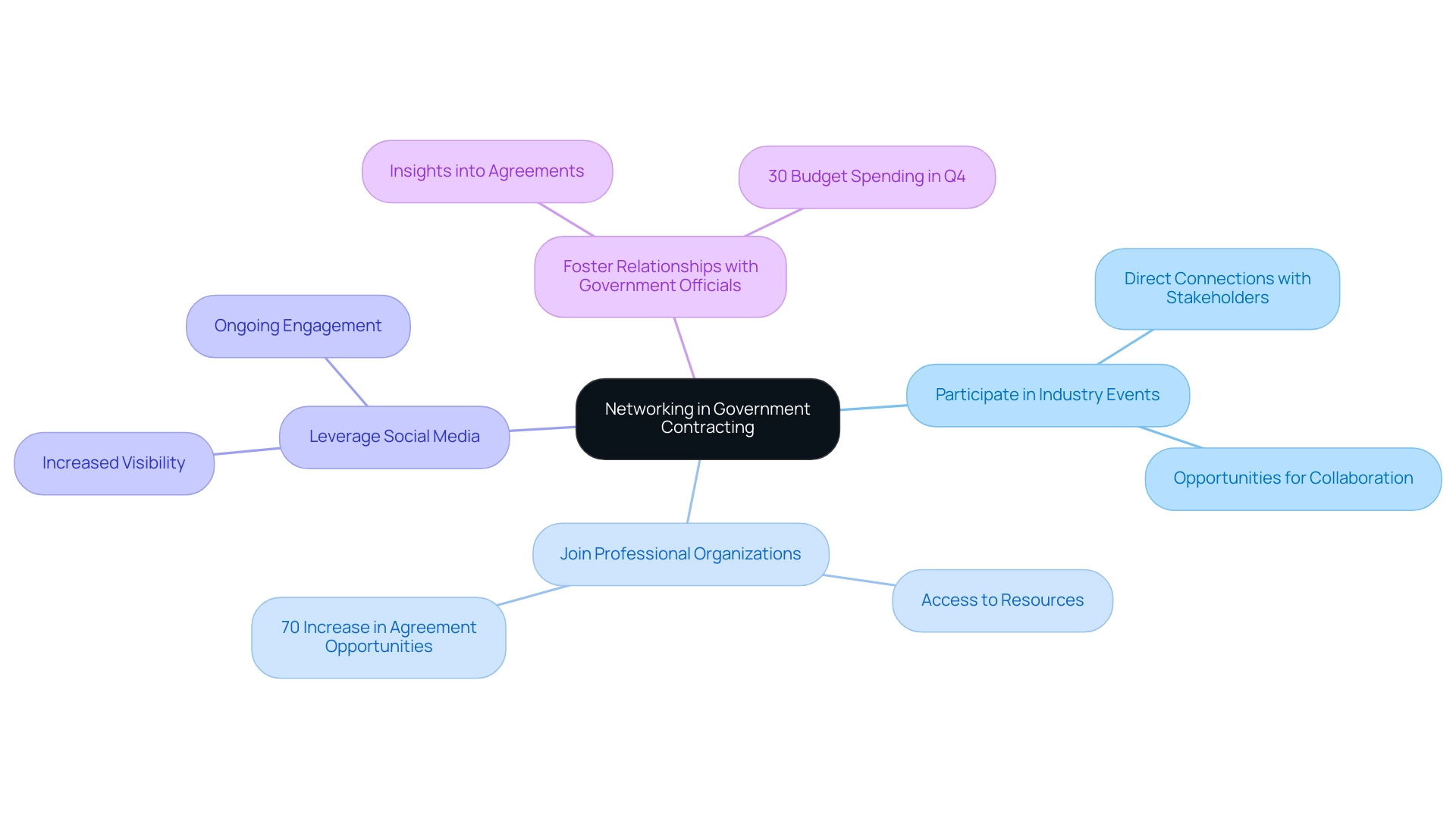
Challenges in Government Contracting: What to Watch Out For
Aspiring contractors often find themselves facing a multitude of challenges in government contracting, and we understand how daunting this journey can be. Compliance with intricate regulations, fierce competition from established contractors, and the risk of delayed payments are just a few of the hurdles that can feel overwhelming. In 2025, companies will encounter significant compliance hurdles, with potential fines reaching up to £18 million or 10% of worldwide revenue for violations of the Online Safety Act. This reality underscores the necessity for businesses to stay informed about regulatory changes and to implement robust compliance strategies.
Moreover, the bidding process can be intimidating. It’s essential for contractors to approach it with a clear understanding of their capabilities and realistic expectations regarding agreement outcomes. For instance, a notable case study reveals the federal authority’s increasing focus on disaster relief and emergency preparedness, which could be a vital area for aspiring contractors to explore.
Contractors in this sector are encouraged to update their System for Award Management (SAM) profiles to reflect their expertise in ‘Disaster Relief’ and emphasize their rapid response capabilities in capability statements. Building collaborations with various agencies can also enhance visibility and readiness, positioning companies favorably in a competitive landscape.
Payment delays remain a persistent issue, with the average time for payment in government contracts extending significantly in 2025. This reality necessitates strong financial management practices to ensure that businesses can sustain operations during these delays. Clear communication with employees regarding their work status during any potential shutdowns is critical to avoid disputes and facilitate a smooth transition back to work. This communication is essential not only for operational stability but also for maintaining compliance with contractual obligations.
As Parnell Woodard, a Career Ownership Coach, emphasizes, transitioning to career ownership through resources like ‘Your Career 2.0: A Survival Guide for The Battered Career Syndrome and Investor Syndrome’ empowers individuals to navigate these challenges effectively. By taking control of their career paths, aspiring contractors can learn how to become a government contractor, better understand the regulatory landscape, and adopt proactive measures to address compliance challenges. Engaging with industry leaders and leveraging expert insights can provide valuable guidance in overcoming these obstacles, ultimately leading to a more successful experience in agreements.
Additionally, it is important to recognize that GSE is a third-party service firm and not an agency of the U.S. Government, which further clarifies the landscape for aspiring contractors. Remember, you are not alone in this journey; with the right support and resources, you can navigate these challenges and achieve your goals.
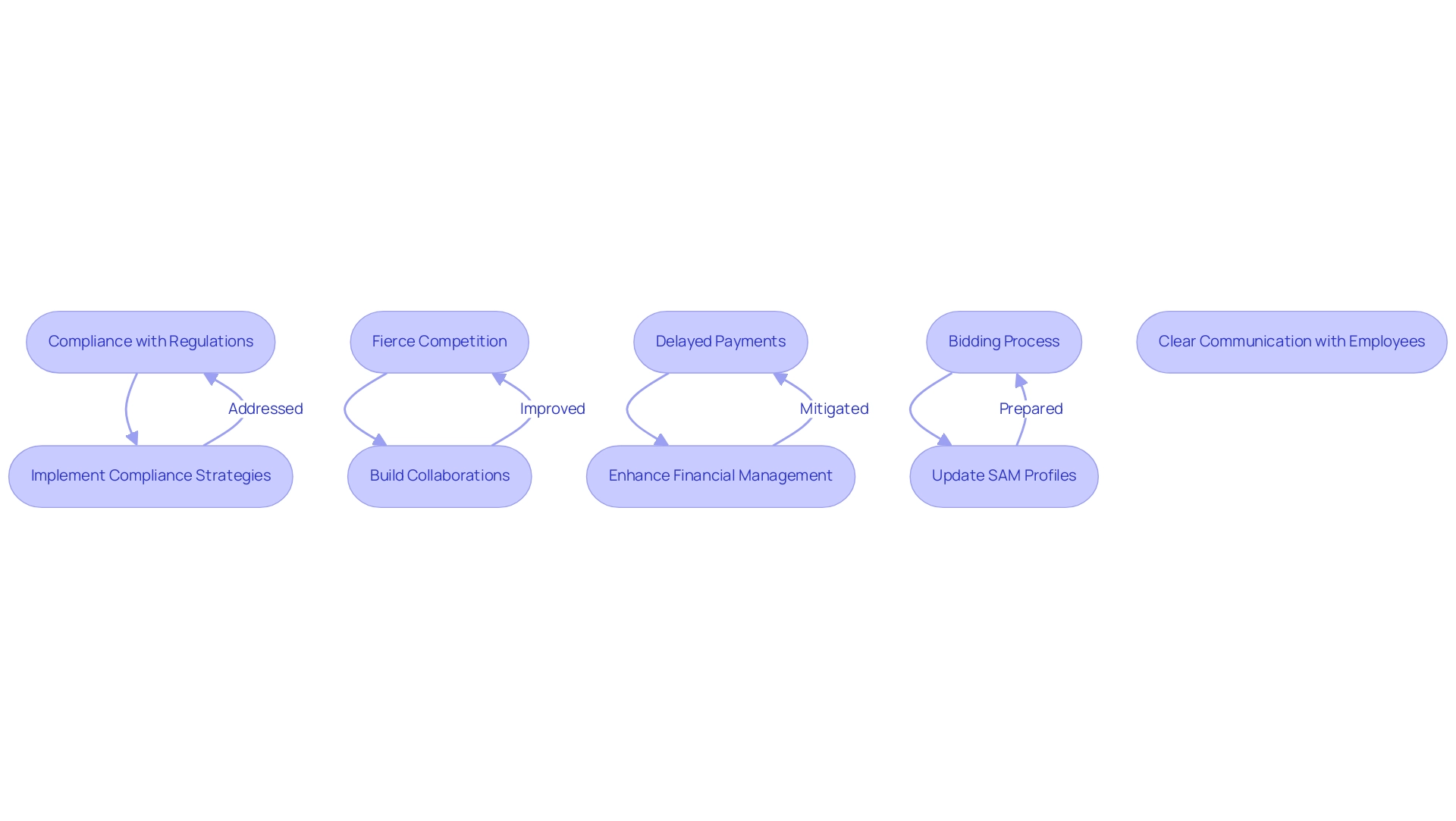
Subcontracting: A Strategic Approach for New Contractors
For new contractors, navigating the journey to becoming a government contractor through subcontracting can feel overwhelming, especially in today’s ever-changing job market. By partnering with established prime contractors, emerging businesses can gain invaluable experience and enhance their credibility in a competitive landscape. This collaborative approach not only opens doors to larger projects but also helps mitigate risks, empowering contractors to take charge of their career paths. Identifying potential prime partners is crucial for new contractors looking to thrive in this environment.
It’s important for them to focus on firms that resonate with their capabilities and values, ensuring a mutually beneficial relationship that fosters community engagement. Understanding the complexities of subcontracting arrangements is equally vital; clear terms can promote cooperation and lay the groundwork for effective project implementation.
As we look ahead to 2025, the benefits of subcontracting in public sector agreements provide insights into how to become a government contractor. With public sector spending in Amusement & Recreation reaching approximately $22.9 billion in January, numerous opportunities await those eager to learn about this space. Recent statistics reveal that federal government job gains were reported at 212 in the fourth quarter of 2023, while job losses stood at 193, highlighting a dynamic environment ripe for new entrants eager to explore this path. Parnell Woodard, a Career Ownership Coach, underscores the importance of transitioning to career ownership for those seeking to flourish in this sector.
Successful subcontracting strategies often involve creating educational content that explains how to navigate the government contracting landscape. This not only establishes authority but also supports SEO efforts. Contractors who address common questions and demonstrate their expertise not only enhance their market position but also build trust with prospective clients—an essential aspect of becoming a government contractor. This approach has proven effective, allowing contractors to rank for additional keywords, thereby increasing visibility and attracting more opportunities.
As businesses continue to globalize, adhering to international regulations becomes crucial. Advanced agreement management systems can help new builders navigate these complexities, ensuring they remain competitive. Experts emphasize the significance of strategic partnerships.
Successful prime contractors frequently advocate for collaboration, highlighting that these alliances can lead to shared resources, knowledge transfer, and increased competitiveness in bidding for public contracts. By leveraging the strengths of established companies, new contractors can learn how to become a government contractor and navigate the intricacies of public sector procurement more effectively, positioning themselves for long-term success and financial independence.
Additionally, the case study on content marketing illustrates how contractors can produce educational materials to establish authority and bolster SEO efforts. This strategy not only aids contractors in ranking for additional keywords but also fosters trust with potential clients, enhancing their market position and empowering them to create the lifestyle they envision. In light of the challenges posed by a declining career economy, subcontracting can serve as a vital tool for new contractors to understand how to become a government contractor, improve their employability, and leverage their transferable skills in a competitive job market.

Resources and Support for Aspiring Government Contractors
Aspiring contractors often face a daunting journey into the competitive world of government contracting. We understand that navigating this landscape can be overwhelming, but there are abundant resources available to support you every step of the way. The Small Business Administration (SBA) is a vital ally, offering a variety of funding options, training programs, workshops, and counseling services designed specifically for public contracting. With the cooperative purchasing market projected to grow from approximately $74 billion in 2024 to nearly $100 billion by 2026, the opportunities are expanding, and you can be part of this growth.
In addition to SBA resources, local APEX Accelerators provide essential support with registration and bidding procedures. This assistance ensures that you are well-equipped to tackle the complexities of public sector agreements. Networking events and industry associations serve as invaluable platforms for you to connect with seasoned professionals who can share their insights and strategies for success. Have you considered how these connections could enhance your journey? Insights from a diverse group of government providers emphasize that leveraging these resources can significantly boost your chances of securing government agreements.
Deniece Peterson, Senior Director of Federal Market Analysis, notes that “although total spending has increased 29.3 percent over the past 5 years, the number of unique or standalone agreements has been declining.” This reality underscores the competitive nature of the market and the necessity of being well-prepared. Case studies reveal that businesses utilizing these resources, especially those participating in SBA training programs and funding opportunities, have reported a better understanding of the bidding process and increased success rates in winning contracts.
By actively engaging with these resources, including the no-cost coaching services offered by The Entrepreneur’s Source, you can learn how to navigate the path to becoming a government contractor. You are not alone in this journey; many have walked this path and found success. Together, we can help you position yourself for success in a rapidly evolving market, benefiting from a structured process that enhances your capabilities. Take the first step toward your career ownership today.
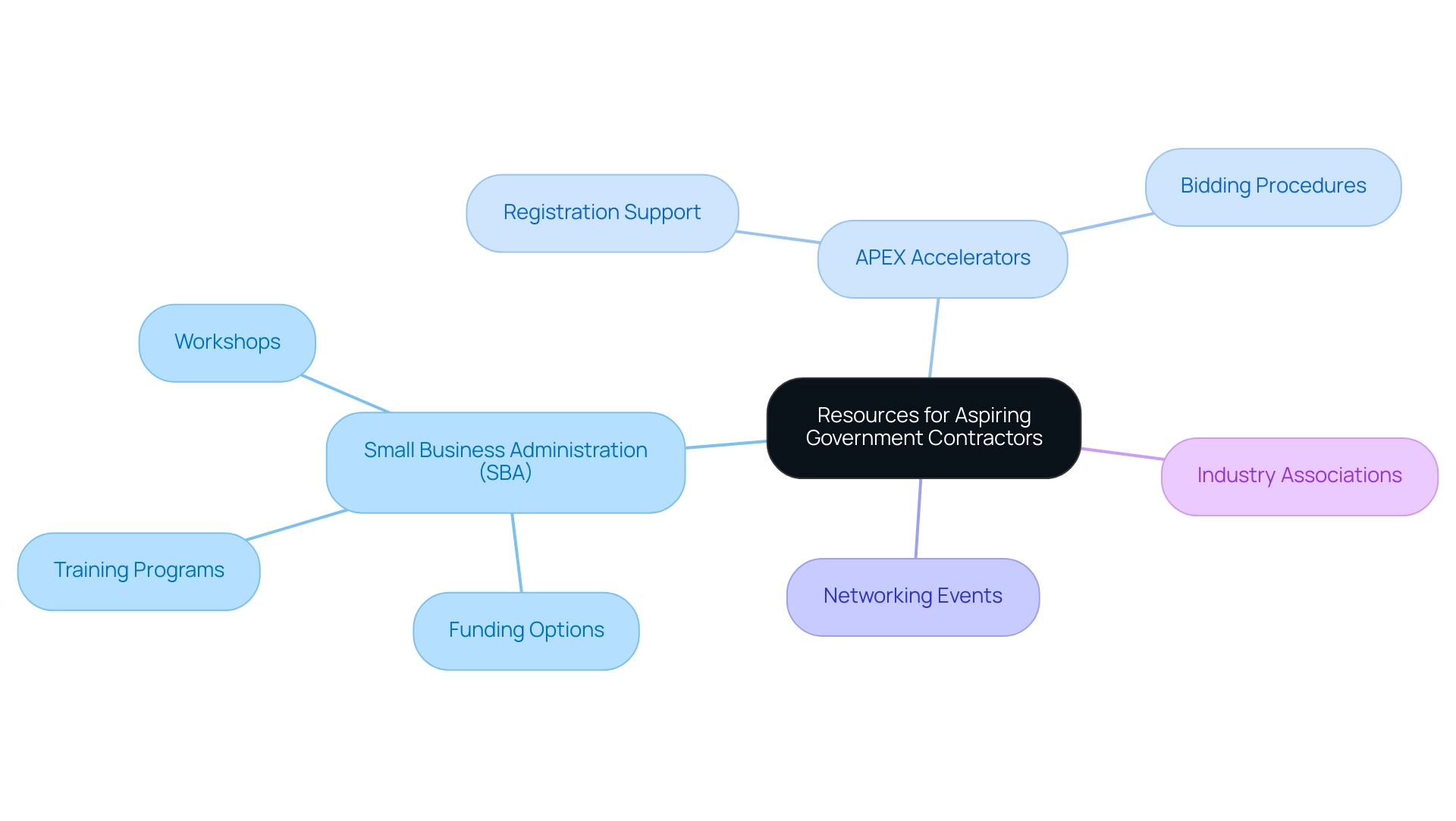
Conclusion
Navigating the world of government contracting can feel daunting, with both significant challenges and remarkable opportunities awaiting businesses, especially as we look toward the evolving landscape of 2025. We understand that grasping the intricacies of this sector is essential for aspiring contractors eager to secure lucrative contracts. Key strategies such as thorough market research, effective registration, and crafting compelling proposals tailored to meet the needs of government agencies can make a substantial difference.
The importance of small and minority-owned businesses is increasingly recognized in the federal contracting arena, and you are not alone in this journey. By leveraging available resources, such as those provided by the Small Business Administration and local APEX Accelerators, you can enhance your understanding of the contracting process, improving your chances of success. Networking within the industry further amplifies these opportunities, allowing you to build meaningful relationships with key stakeholders and stay informed about upcoming contracts.
Ultimately, the journey to becoming a successful government contractor is paved with preparation, strategic planning, and continuous learning. Embracing these principles and utilizing the support systems available can empower you to thrive in this competitive landscape, transforming challenges into growth opportunities. As the government contracting market continues to expand, remember that those who are proactive and well-prepared will be best equipped to reap the rewards of this dynamic field. You have the potential to succeed, and with the right mindset and resources, you can navigate this journey with confidence.
Frequently Asked Questions
What is public sector procurement?
Public sector procurement is the process through which companies can become government contractors by offering a diverse range of products and services while interacting with public entities.
What challenges does the government procurement landscape face as we approach 2025?
A significant challenge is the estimated $131.8 billion of federal spending in 2021 that remains unaccounted for, highlighting the critical need for transparency and accountability in procurement processes.
How are small businesses performing in government contracting?
There has been a notable increase in contract awards for small businesses, which underscores their importance in the federal procurement landscape, despite a decline in prime opportunities.
What role does the Small Business Administration (SBA) play in federal contracting?
The SBA has started releasing disaggregated data on federal contracting with small and minority-owned businesses, promoting transparency and support for these firms.
What sectors have seen successful examples of public contracts?
Successful examples can be found in sectors like disaster relief and emergency preparedness, where federal authorities prioritize contracts in logistics, construction, healthcare, and emergency management.
How can contractors enhance their visibility in the procurement process?
Contractors can enhance their visibility by updating their System for Award Management (SAM) profiles with relevant keywords and emphasizing their rapid response capabilities.
What is the significance of public sector agreements for small businesses?
Public sector agreements provide small enterprises with steady income, foster lasting partnerships, and enhance their reputation, often facing less competition compared to the private sector.
What percentage of federal spending on contracts is anticipated to be captured by small enterprises by 2025?
Small enterprises are projected to capture approximately 23% of federal spending on contracts.
How can small businesses benefit from becoming government contractors?
Businesses awarded public contracts report an average revenue growth of 30% within their first year, significantly impacting their long-term sustainability and growth trajectory.
What support systems are available for minority-owned businesses in public sector procurement?
Inclusive support systems are essential to empower various communities in entrepreneurship, particularly in public sector procurement, as highlighted by the diversity of small business ownership.
What resources does The Entrepreneur’s Source provide for aspiring government contractors?
The Entrepreneur’s Source offers Career Ownership Coaching™, helping individuals understand the nuances of becoming a government contractor and enhancing their career prospects.
What initial steps should a company take to become a government contractor?
Companies should assess their capabilities, conduct market research, gather essential documentation, and ensure compliance with federal regulations.
What funding options are available for small businesses entering the contracting sector?
The U.S. Small Business Administration offers funding opportunities, including loans and grants, to assist small businesses in entering the contracting sector.
How can insights from successful contractors aid new entrants in public procurement?
Insights from successful contractors can provide valuable guidance on thorough preparation and understanding the specific requirements of public contracts, which are key to success.
What role does coaching play in navigating the public procurement landscape?
Coaching services, such as those offered by Find Your Career 2.0, help individuals understand compliance requirements and prepare effectively for becoming government contractors.


